Formation (association football)
In association football, the formation describes how the players in a team generally position themselves on the pitch. Association football is a fluid and fast-moving game, and (with the exception of the goalkeeper) a player's position in a formation does not define their role as rigidly as for, for instance, a rugby player, nor are there episodes in play where players must expressly line up in formation (as in gridiron football). Nevertheless, a player's position in a formation generally defines whether a player has a mostly defensive or attacking role, and whether they tend to play towards one side of the pitch or centrally.
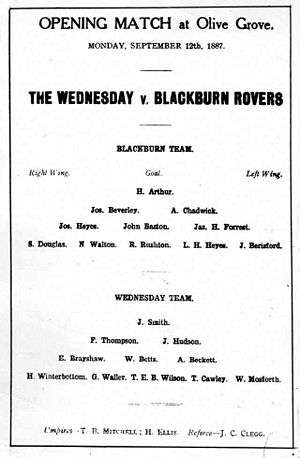
Formations are typically described by three or four numbers, which denote how many players are in each row of the formation from the most defensive to the most forward. For example, the popular "4–5–1" formation has four defenders, five midfielders, and a single forward. Different formations can be used depending on whether a team wishes to play more attacking or defensive football, and a team may switch formations between or during games for tactical reasons.
The choice of formation is typically made by a team's manager or head coach. Skill and discipline on the part of the players is needed to implement a given formation effectively in professional football. Formations need to be chosen bearing in mind which players are available. Some formations were created to address deficits or strengths in different types of players.
In the early days of football, most team members would play in attacking roles, whereas modern formations almost always have more defenders than forwards.
Nomenclature
Formations are described by categorising the players (not including the goalkeeper) according to their positioning along (not across) the pitch, with the more defensive players given first. For example, 4–4–2 means four defenders, four midfielders, and two forwards.
Traditionally, those within the same category (for example the four midfielders in a 4–4–2) would generally play as a fairly flat line across the pitch, with those out wide often playing in a slightly more advanced position. In many modern formations, this is not the case, which has led to some analysts splitting the categories in two separate bands, leading to four- or even five-numbered formations. A common example is 4–2–1–3, where the midfielders are split into two defensive and one offensive player; as such, this formation can be considered a type of 4–3–3. An example of a five-numbered formation would be 4–1–2–1–2, where the midfield consists of a defensive midfielder, two central midfielders and an offensive midfielder; this is sometimes considered to be a kind of 4–4–2 (specifically a 4–4–2 diamond, referring to the lozenge shape formed by the four midfielders).
The numbering system was not present until the 4–2–4 system was developed in the 1950s.
Choice and uses of formations
The choice of formation is often related to the type of players available to the coach.
- Narrow formations. Teams with a surfeit of central midfielders, or teams who attack best through the centre, may choose to adopt narrow formations such as the 4–1–2–1–2 or the 4–3–2–1 which allow teams to field up to four or five central midfielders in the team. Narrow formations, however, depend on the full-backs (the flank players in the "4") to provide width and to advance upfield as frequently as possible to supplement the attack in wide areas.
- Wide formations. Teams with a surfeit of forwards and wingers may choose to adopt formations such as 4–2–3–1, 3–5–2 and 4–3–3, which commit forwards and wingers high up the pitch. Wide formations allow the attacking team to stretch play and cause the defending team to cover more ground.
Teams may change formations during a game to aid their cause:
- Change to attacking formations. When chasing a game for a desirable result, teams tend to sacrifice a defensive player or a midfield player for a forward in order to chase a result. An example of such a change is a change from 4–5–1 to 4–4–2, 3–5–2 to 3–4–3, or even 5–3–2 to 4–3–3.
- Change to defensive formations. When a team is in the lead, or wishes to protect the scoreline of a game, the coach may choose to revert to a more defensive structure by removing a forward for a more defensive player. The extra player in defence or midfield adds solidity by giving the team more legs to chase opponents and recover possession. An example of such a change is a change from 4–4–2 to 5–3–2, 3–5–2 to 4–5–1, or even 4–4–2 to 5–4–1.
Formations can be deceptive in analysing a particular team's style of play. For instance, a team that plays a nominally attacking 4–3–3 formation can quickly revert to a 4–5–1 if a coach instructs two of the three forwards to track back in midfield.
Early formations
In the football matches of the 19th century, defensive football was not played, and the line-ups reflected the all-attacking nature of these games.
In the first international game, Scotland against England on 30 November 1872, England played with seven or eight forwards in a 1–1–8 or 1–2–7 formation, and Scotland with six, in a 2–2–6 formation. For England, one player would remain in defence, picking up loose balls, and one or two players would hang around midfield and kick the ball upfield for the other players to chase. The English style of play at the time was all about individual excellence and English players were renowned for their dribbling skills. Players would attempt to take the ball forward as far as possible and only when they could proceed no further, would they kick it ahead for someone else to chase. Scotland surprised England by actually passing the ball among players. The Scottish outfield players were organised into pairs and each player would always attempt to pass the ball to his assigned partner. Ironically, with so much attention given to attacking play, the game ended in a 0–0 draw.
Classic formations
2–3–5 (Pyramid)
.svg.png)
The first long-term successful formation was first recorded in 1880.[1] In Association Football, however, published by Caxton in 1960, the following appears in Vol II, page 432: "Wrexham ... the first winner of the Welsh Cup in 1877 ... for the first time certainly in Wales and probably in Britain, a team played three half-backs and five forwards ..."
The 2–3–5 was originally known as the "Pyramid", with the numerical formation being referenced retrospectively. By the 1890s, it was the standard formation in England and had spread all over the world. With some variations, it was used by most top-level teams up to the 1930s.
For the first time, a balance between attacking and defending was reached. When defending, the two defenders (full-backs), would zonally mark the opponent forwards (mainly the central trio), while the midfielders (halfbacks) would fill the gaps (usually marking the opposing wingers or inside forwards).
The centre halfback had a key role in both helping to organise the team's attack and marking the opponent's centre forward, supposedly one of their most dangerous players.
This formation was used by Uruguay national team to win the 1924 and 1928 Olympic Games and also the 1930 FIFA World Cup.
It was this formation which gave rise to the convention of shirt numbers increasing from the back and the right.[2]
Danubian School
The Danubian School of football is a modification of the 2–3–5 formation in which the centre forward plays in a more withdrawn position. As played by the Austrians, Czechs and Hungarians in the 1920s, it was taken to its peak by the Austrians in the 1930s. It relied on short-passing and individual skills. This school was heavily influenced by the likes of Hugo Meisl and Jimmy Hogan, the English coach who visited Austria at the time.
Metodo (2–3–2–3)
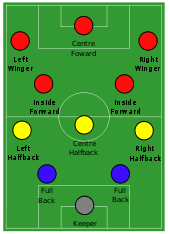
The Metodo was devised by Vittorio Pozzo, coach of the Italy national team in the 1930s.[3] It was a derivation of the Danubian School. The system was based on the 2–3–5 formation; Pozzo realised that his half-backs would need some more support in order to be superior to the opponents' midfield, so he pulled two of the forwards to just in front of midfield, creating a 2–3–2–3 formation. This created a stronger defence than previous systems, as well as allowing effective counter-attacks. The Italian national team won back-to-back World Cups in 1934 and 1938 using this system. It has been argued that Pep Guardiola's Barcelona and Bayern Munich used a modern version of this formation.[4] This formation is also similar to the standard in table football, featuring two defenders, five midfielders and three strikers (which cannot be altered as the "players" are mounted on axles).
WM
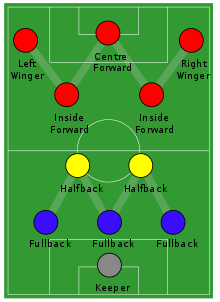
The WM system, known for the shapes described by the positions of the players, was created in the mid-1920s by Herbert Chapman of Arsenal to counter a change in the offside law in 1925. The change had reduced the number of opposition players that attackers needed between themselves and the goal-line from three to two. This led to the introduction of a centre-back to stop the opposing centre-forward, and tried to balance defensive and offensive playing. The formation became so successful that by the late-1930s most English clubs had adopted the WM. Retrospectively, the WM has either been described as a 3–2–5 or as a 3–4–3, or more precisely a 3–2–2–3 reflecting the letters which symbolised it. The gap in the centre of the formation between the two wing halves and the two inside forwards allowed Arsenal to counter-attack effectively. The WM was subsequently adapted by several English sides, but none could apply it in quite the same way Chapman had. This was mainly due to the comparative rarity of players like Alex James in the English game. He was one of the earliest playmakers in the history of the game, and the hub around which Chapman's Arsenal revolved. In 2016, new manager Patrick Vieira, a former Arsenal player, brought the WM formation to New York City FC.[5] In Italian football, the WM system was known as the "sistema", and its use in Italy later led to the development of the catenaccio system.[6]
WW
The WW was a development of the WM created by the Hungarian coach Márton Bukovi who turned the 3–2–5 WM into a 2–3–2–3 by effectively turning the M "upside down".[7] The lack of an effective centre-forward in his team necessitated moving this player back to midfield to create a playmaker, with a midfielder instructed to focus on defence. This created a 2–3–1–4, which morphed into a 2–3–2–3 when the team lost possession, and was described by some as a kind of genetic link between the WM and the 4–2–4. This formation was successfully used by fellow countryman Gusztáv Sebes in the Hungary national team of the early 1950s.
3–3–4
The 3–3–4 formation was similar to the WW, with the notable exception of having an inside-forward (as opposed to centre-forward) deployed as a midfield schemer alongside the two wing-halves. This formation would be commonplace during the 1950s and early 1960s. One of the best exponents of the system was the Tottenham Hotspur double-winning side of 1961, which deployed a midfield of Danny Blanchflower, John White and Dave Mackay. Porto won the 2005–06 Primeira Liga using this unusual formation under manager Co Adriaanse.
4–2–4
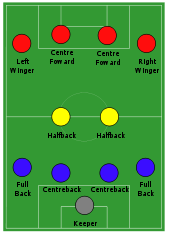
The 4–2–4 formation attempts to combine a strong attack with a strong defence, and was conceived as a reaction to WM's stiffness. It could also be considered a further development of the WW. The 4–2–4 was the first formation to be described using numbers.
While the initial developments leading to the 4–2–4 were devised by Márton Bukovi, the credit for creating the 4–2–4 lies with two people: Flávio Costa, the Brazilian national coach in the early 1950s, as well as another Hungarian, Béla Guttman. These tactics seemed to be developed independently, with the Brazilians discussing these ideas while the Hungarians seemed to be putting them into motion.[7][8][9] The fully developed 4–2–4 was only "perfected" in Brazil, however, in the late 1950s.
Costa published his ideas, the "diagonal system", in the Brazilian newspaper O Cruzeiro, using schematics as the ones used here and, for the first time ever, the formation description by numbers as used in this article.[8] The "diagonal system" was another precursor of the 4–2–4 and was created to spur improvisation in players.
Guttmann himself moved to Brazil later in the 1950s to help develop these tactical ideas using the experience of Hungarian coaches.
The 4–2–4 formation made use of the players' increasing levels of skill and fitness, aiming to effectively use six defenders and six forwards, with the midfielders performing both tasks. The fourth defender increased the number of defensive players but mostly allowed them to be closer together, thus enabling effective cooperation among them, the point being that a stronger defence would allow an even stronger attack.
The relatively empty midfield relied on defenders that should now be able not only to steal the ball, but also hold it, pass it or even run with it and start an attack. So this formation required that all players, including defenders, are somehow skilful and with initiative, making it a perfect fit for the Brazilian player's mind. The 4–2–4 needed a high level of tactical awareness, as having only two midfielders could lead to defensive problems. The system was also fluid enough to allow the formation to change throughout play.
4–2–4 was first used with success at club level in Brazil by Palmeiras and Santos, and was used by Brazil in their wins at 1958 World Cup and 1970 World Cup, both featuring Pelé, and Mário Zagallo, the latter of which played in 1958 and coached in 1970. The formation was quickly adopted throughout the world after the Brazilian success. Under the management of Jock Stein, Celtic won the 1966–67 European Cup and reached the final of the 1969–70 European Cup using this formation.
Common modern formations
|
The following formations are used in modern football. The formations are flexible allowing tailoring to the needs of a team, as well as to the players available. Variations of any given formation include changes in positioning of players, as well as replacement of a traditional defender by a sweeper.
4–4–2
This formation was the most common in football in the 1990s and early 2000s, so well known that it inspired the title of the magazine FourFourTwo. The midfielders are required to work hard to support both the defence and the attack: typically one of the central midfielders is expected to go upfield as often as possible to support the forward pair, while the other will play a "holding role", shielding the defence; the two wide midfield players must move up the flanks to the goal line in attacks and yet also protect the full-backs.[10][11] On the European level, the major example of a team using a 4–4–2 formation was Milan, trained by Arrigo Sacchi and later Fabio Capello, which won three European Cups, two Intercontinental Cups, and three UEFA Super Cups between 1988 and 1995.[12] Under Milan's example, it became very popular in Italy in the late 1980s and early 1990s.
More recently, commentators have noted that at the highest level, the 4–4–2 is being phased out in favour of formations such as the 4–2–3–1.[13] In 2010, none of the winners of the Spanish, English and Italian leagues, nor the Champions League, relied on the 4–4–2. Following England's elimination at the 2010 World Cup by a 4–2–3–1 Germany side, England national team coach Fabio Capello (who was notably successful with the 4–4–2 at Milan in the 1990s) was criticised for playing an "increasingly outdated" 4–4–2 formation.[14]
However, the 4–4–2 is still regarded as the best formation to protect the whole width of the field with the opposing team having to get past two banks of four and has recently had a tactical revival having recently contributed to Diego Simeone's Atlético Madrid, Carlo Ancelotti's Real Madrid and Claudio Ranieri's Leicester City.[15][16]
4–4–1–1
A variation of 4–4–2 with one of the strikers playing "in the hole", or as a "second striker", slightly behind their partner.[17] The second striker is generally a more creative player, the playmaker, who can drop into midfield to pick up the ball before running with it or passing to teammates.[17] Interpretations of 4–4–1–1 can be slightly muddled, as some might say that the extent to which a forward has dropped off and separated himself from the other can be debated. The system was most prominently used during the 2009–10 season by Fulham, with midfielder Zoltán Gera playing behind forward Bobby Zamora as they upset many teams across Europe en route to the 2010 UEFA Europa League Final.
4–3–3
The 4–3–3 was a development of the 4–2–4, and was played by the Brazilian national team in the 1962 World Cup, although a 4–3–3 had also previously been used by the Uruguay national team in the 1950 and 1954 World Cups. The extra player in midfield allows a stronger defence, and the midfield could be staggered for different effects. The three midfielders normally play closely together to protect the defence, and move laterally across the field as a coordinated unit. The three forwards split across the field to spread the attack, and may be expected to mark the opposition full-backs as opposed to doubling back to assist their own full-backs, as do the wide midfielders in a 4–4–2. When used from the start of a game, this formation is widely regarded as encouraging expansive play, and should not be confused with the practice of modifying a 4–4–2 by bringing on an extra forward to replace a midfield player when behind in the latter stages of a game. This formation is suited for a short passing game and useful for ball retention.
A staggered 4–3–3 involving a defensive midfielder (usually numbered four or six) and two attacking midfielders (numbered eight and ten) was commonplace in Italy, Argentina, and Uruguay during the 1960s and 1970s. The Italian variety of 4–3–3 was simply a modification of WM, by converting one of the two wing-halves to a libero (sweeper), whereas the Argentine and Uruguayan formations were derived from 2–3–5 and retained the notional attacking centre-half. The national team that made this famous was the Dutch team of the 1974 and 1978 World Cups, even though the team won neither.
In club football, the team that brought this formation to the forefront was the famous Ajax team of the early 1970s, which won three European Cups with Johan Cruyff, and Zdeněk Zeman with Foggia in Italy during the late 1980s, where he completely revitalised the movement supporting this formation. It was also the formation with which Norwegian manager Nils Arne Eggen won 15 Norwegian league titles.
Most teams using this formation now use the specialist defensive midfielder. Recent famous examples include the Porto and Chelsea teams coached by José Mourinho, as well as the Barcelona team under Pep Guardiola. Mourinho has also been credited with bringing this formation to England in his first stint with Chelsea, and it is commonly used by Guardiola's Manchester City.
4–3–1–2
A variation of the 4–3–3 wherein a striker gives way to a central attacking midfielder. The formation focuses on the attacking midfielder moving play through the centre with the strikers on either side. It is a much narrower setup in comparison to the 4–3–3 and is usually dependent on the "1" to create chances. Examples of sides which won trophies using this formation were the 2002–03 UEFA Cup and 2003–04 UEFA Champions League winner José Mourinho's Porto side; Carlo Ancelotti's 2002–03 UEFA Champions League and 2003–04 Serie A champion Milan, and 2009–10 Premier League winner Chelsea. This formation was also adopted by Massimiliano Allegri for the 2010–11 Serie A title-winning season for Milan. It was also the favoured formation of Maurizio Sarri during his time at Empoli between 2012 and 2015, during which time they won promotion to Serie A and subsequently avoided relegation, finishing 15th in the 2014–15 Serie A season.
4–1–2–3
A variation of the 4–3–3 with a defensive midfielder, two central midfielders and a fluid front three.[18]
4–4–2 diamond or 4–1–2–1–2
The 4–4–2 diamond (also described as 4–1–2–1–2) staggers the midfield. The width in the team has to come from the full-backs pushing forward. The defensive midfielder is sometimes used as a deep lying playmaker, but needs to remain disciplined and protect the back four behind him.[19] The central attacking midfielder is the creative player, responsible for picking up the ball, and distributing the ball wide to its full-backs or providing the two strikers with through balls.[20] When out of possession, the midfield four must drop and assist the defence, while the two strikers must be free for the counter-attack.[20] Its most famous example was Carlo Ancelotti's Milan, which won the 2003 UEFA Champions League Final and made Milan runners-up in 2005. Milan was obliged to adopt this formation so as to field talented central midfielder Andrea Pirlo, in a period when the position of offensive midfielder was occupied by Rui Costa and later Kaká.[21] This tactic was gradually abandoned by Milan after Andriy Shevchenko's departure in 2006, progressively adopting a "Christmas Tree" formation. Earlier, Dinamo Tbilisi used this formation in their successful 1981 Cup Winner's Cup campaign, David Kipiani playing the role of the central attacking midfielder.
4–1–3–2
The 4–1–3–2 is a variation of the 4–1–2–1–2 and features a strong and talented defensive centre midfielder. This allows the remaining three midfielders to play further forward and more aggressively, and also allows them to pass back to their defensive mid when setting up a play or recovering from a counterattack. The 4–1–3–2 gives a strong presence in the forward middle of the pitch and is considered to be an attacking formation. Opposing teams with fast wingers and strong passing abilities can try to overwhelm the 4–1–3–2 with fast attacks on the wings of the pitch before the three offensive midfielders can fall back to help their defensive line. Valeriy Lobanovskiy is one of the most famous exponents of the formation, using it with Dynamo Kyiv, winning three European trophies in the process. Another example of the 4–1–3–2 in use was the England national team at the 1966 World Cup, managed by Alf Ramsey.
4–3–2–1 (the "Christmas Tree" formation)
The 4–3–2–1, commonly described as the "Christmas Tree" formation, has another forward brought on for a midfielder to play "in the hole", so leaving two forwards slightly behind the most forward striker.
Terry Venables and Christian Gross used this formation during their time in charge of Tottenham Hotspur. Since then, the formation has lost its popularity in England.[22] It is, however, most known for being the formation Carlo Ancelotti used on-and-off during his time as a coach of Milan.
In this approach, the middle of the three central midfielders act as a playmaker while one of the attacking midfielders plays in a free role. However, it is also common for the three midfielders to be energetic shuttlers, providing for the individual talent of the two attacking midfielders ahead. The "Christmas Tree" formation is considered a relatively narrow formation and depends on full-backs to provide presence in wide areas. The formation is also relatively fluid. During open play, one of the side central midfielders may drift to the flank to add additional presence.
5–3–2
This formation has three central defenders, possibly with one acting as a sweeper. This system merges the winger and full-back positions into the wing-back, whose job it is to work their flank along the full length of the pitch, supporting both the defence and the attack.[23] At club level, the 5–3–2 was famously employed by Helenio Herrera in his Inter Milan side, influencing many other Italian teams of the era.[24] The Brazil team which was runner-up at the 1998 and winner of the 2002 FIFA World Cups also employed this formation with their wing-backs Cafu and Roberto Carlos two of the best known proponents of this position.[25]
5–3–2 with sweeper or 1–4–3–2
A variant of the 5–3–2, this involves a more withdrawn sweeper, who may join the midfield, and more advanced full-backs.
3–4–3
Using a 3–4–3, the midfielders are expected to split their time between attacking and defending. Having only three dedicated defenders means that if the opposing team breaks through the midfield, they will have a greater chance to score than with a more conventional defensive configuration, such as 4–5–1 or 4–4–2. However, the three forwards allow for a greater concentration on attack. This formation is used by more offensive-minded teams. The formation was famously used by Liverpool under Rafael Benítez during the second half of the 2005 UEFA Champions League Final to come back from a three-goal deficit.
Ex-Juventus and Italy coach Antonio Conte successfully implemented the 3–4–3 at Chelsea during the 2016–17 Premier League season, leading the club to the league title and an FA Cup final. In order to properly counteract the additional forward pressure from the wing-backs in the system, other sides, including Ronald Koeman's Everton and Mauricio Pochettino's Tottenham, also used the formation against Chelsea.[26][27]
3–5–2
This formation is similar to 5–3–2, but with some important tweaks: there is usually no sweeper (or libero) but rather three classic centre-backs, and the two wing-backs are oriented more towards the attack. Because of this, the central midfielder tends to remain further back in order to help prevent counter-attacks. It also differs from the classical 3–5–2 of the WW by having a non-staggered midfield. There are several coaches claiming to be the inventors of this formation, but the first to successfully employ it at the highest level was Carlos Bilardo, who led Argentina to win the 1986 World Cup using the 3–5–2.[28] The high point of the 3–5–2's influence was the 1990 World Cup, with both finalists, Bilardo's Argentina and Franz Beckenbauer's West Germany employing it.[28]
Although it had fallen out of favour with most coaches who now prefer four at the back, it had a renaissance in both club and international football in the 2010s. At club level, it has been effectively utilised by Antonio Conte in his stints as manager of Juventus and Inter Milan in Italy and Chelsea in England, and, at international level, by Louis van Gaal with the Netherlands in the 2014 World Cup, in which they finished third.[29] Notably, this formation was specifically employed as a counter to the challenge of possession football used by the Spanish national side. Cesare Prandelli used it for Italy's 1–1 draw with Spain in the group stage of Euro 2012, with some commentators seeing Daniele De Rossi as a sweeper.[30] The Netherlands used it to greater effect against Spain during the group stage of the 2014 World Cup, completing a 5–1 win. This was successful in minimizing the Dutch weaknesses (inexperience in defence) and maximising their strengths (world-class forwards in Robin van Persie and Arjen Robben).[31]
3–4–1–2
3–4–1–2 is a variant of 3–5–2 where the wingers are more withdrawn in favour of one of the central midfielders being pushed further upfield into the "number 10" playmaker position. Martin O'Neill successfully used this formation during the early years of his reign as Celtic manager, noticeably taking them to the 2003 UEFA Cup Final.
3–6–1
This uncommon modern formation focuses on ball possession in the midfield. In fact, it is very rare to see it as an initial formation, as it is more useful for maintaining a lead or tie score. Its more common variants are 3–4–2–1 or 3–4–3 diamond, which use two wing-backs. The lone forward must be tactically gifted, not only because he focuses on scoring but also on assisting with back passes to his teammates. Once the team is leading the game, there is an even stronger tactical focus on ball control, short passes and running down the clock. On the other hand, when the team is losing, at least one of the playmakers will more frequently play on the edge of the area to add depth to the attack. Steve Sampson (for the US in the 1998 World Cup) and Guus Hiddink (for Australia during the 2006 World Cup) are two of the few coaches who have used this formation.
4–5–1
4–5–1 is a defensive formation; however, if the two midfield wingers play a more attacking role, it can be likened to 4–3–3. The formation can be used to grind out 0–0 draws or preserve a lead, as the packing of the centre midfield makes it difficult for the opposition to build up play.[32] Because of the "closeness" of the midfield, the opposing team's forwards will often be starved of possession. Due to the lone striker, however, the centre of the midfield does have the responsibility of pushing forward as well. The defensive midfielder will often control the pace of the game.[33]
4–2–3–1
This formation is widely used by Spanish, French and German sides. While it seems defensive to the eye, it is quite a flexible formation, as both the wide players and the full-backs join the attack. In defence, this formation is similar to either the 4–5–1 or 4–4–1–1. It is used to maintain possession of the ball and stopping opponent attacks by controlling the midfield area of the field. The lone striker may be very tall and strong to hold the ball up as his midfielders and full-backs join him in attack. The striker could also be very fast. In these cases, the opponent's defence will be forced to fall back early, thereby leaving space for the offensive central midfielder. This formation is used especially when a playmaker is to be highlighted. The variations of personnel used on the flanks in this set-up include using traditional wingers, using inverted wingers or simply using wide midfielders. Different teams and managers have different interpretations of the 4–2–3–1, but one common factor among them all is the presence of the double pivot. The double pivot is the usage of two holding midfielders in front of the defence.
At international level, this formation is used by the Belgian, French, Dutch and German national teams in an asymmetric shape, and often with strikers as wide midfielders or inverted wingers. The formation is also currently used by Brazil as an alternative to the 4–2–4 formation of the late 1950s to 1970. Implemented similarly to how the original 4–2–4 was used back then, use of this formation in this manner is very offensive, creating a six-man attack and a six-man defence tactical layout. The front four attackers are arranged as a pair of wide forwards and a playmaker forward who play in support of a lone striker. Mário Zagallo also considers the Brazil 1970 football team he coached as pioneers of 4–2–3–1.[34]
In recent years, with full-backs having ever more increasing attacking roles, the wide players (be they deep lying forwards, inverted wingers, attacking wide midfielders) have been tasked with the defensive responsibility to track and pin down the opposition full-backs.
This formation has been very frequently used by managers all over the world in the modern game. One particularly effective use of it was Liverpool under Rafael Benítez, who deployed Javier Mascherano, Xabi Alonso and Steven Gerrard in central midfield, with Gerrard acting in a more advanced role in order to link up with Fernando Torres, who acted as the central striker. Another notable example at club level is Bayern Munich under Jupp Heynckes.
4–6–0
A highly unconventional formation, the 4–6–0 is an evolution of the 4–2–3–1 or 4–3–3 in which the centre forward is exchanged for a player who normally plays as a trequartista (that is, in the "hole"). Suggested as a possible formation for the future of football,[35] the formation sacrifices an out-and-out striker for the tactical advantage of a mobile front four attacking from a position that the opposition defenders cannot mark without being pulled out of position.[36] Because of the intelligence and pace required by the front four attackers to create and attack any space left by the opposition defenders, however, the formation requires a very skilful and well-drilled front four. Due to these demanding requirements from the attackers, and the novelty of playing without a proper goalscorer, the formation has been adopted by very few teams, and rarely consistently. As with the development of many formations, the origins and originators are uncertain, but arguably the first reference to a professional team adopting a similar formation is Anghel Iordănescu's Romania in the 1994 World Cup Round of 16, when Romania won 3–2 against Argentina.[37][38] The first team to adopt the formation systematically was Luciano Spalletti's Roma side during the 2005–06 Serie A season, mostly out of necessity as his "strikerless" formation,[39] and then notably by Alex Ferguson's Manchester United side that won the Premier League and Champions League in 2007–08.[40] The formation was unsuccessfully used by Craig Levein's Scotland against Czech Republic to widespread condemnation.[41] At Euro 2012, Spain coach Vicente del Bosque used the 4–6–0 for his side's 1–1 group stage draw against Italy and their 4–0 win versus Italy in the final of the tournament.[42]
5–4–1
This is a particularly defensive formation, with an isolated forward and a packed defence. Again, however, a couple of attacking full-backs can make this formation resemble something like a 3–6–1. One of the most famous cases of its use is the Euro 2004-winning Greek national team.
1–6–3
The 1–6–3 formation was first used by Japan at the behest of General Yoshijirō Umezu in 1936. Famously, Japan defeated the heavily favoured Swedish team 3–2 at the 1936 Olympics with the unorthodox 1–6–3 formation, before going down 0–8 to Italy. The formation was dubbed the "kamikaze" formation sometime in the 1960s when former United States national team player Walter Bahr used it for a limited number of games as coach of the Philadelphia Spartans to garner greater media and fan attention for the struggling franchise.[43]
4–2–2–2 (Magic Rectangle)
Often referred to as the "Magic Rectangle" or "Magic Square",[44] this formation was used by France under Michel Hidalgo at the 1982 World Cup and Euro 1984, and later by Henri Michel at the 1986 World Cup[45] and a whole generation, for Brazil with Telê Santana, Carlos Alberto Parreira and Vanderlei Luxemburgo, by Arturo Salah and Manuel Pellegrini in Chile and Francisco Maturana in Colombia.[46] The "Magic Rectangle" is formed by combining two box-to-box midfielders with two deep-lying ("hanging") forwards across the midfield. This provides a balance in the distribution of possible moves and adds a dynamic quality to midfield play.
This formation was used by former Real Madrid manager Manuel Pellegrini and met with considerable praise.[47] Pellegrini also used this formation while with Villarreal and Málaga. The formation is closely related to a 4–2–4 previously used by Fernando Riera, Pellegrini's mentor,[48] and that can be traced back to Chile in 1962 who (may have) adopted it from the Frenchman Albert Batteux at the Stade de Reims of 50s.
This formation had been previously used at Real Madrid by Vanderlei Luxemburgo during his failed stint at the club during the latter part of the 2004–05 season and throughout the 2005–06 season. This formation has been described as being "deeply flawed"[49] and "suicidal".[50] Luxemburgo is not the only one to use this although it had been used earlier by Brazil in the early 1980s.[51][52] At first, Telê Santana, then Carlos Alberto Parreira and Vanderlei Luxemburgo proposed basing the "Magic Rectangle" on the work of the wing-backs. The rectangle becomes a 3–4–3 on the attack because one of the wing-backs moves downfield.[53]
In another sense, the Colombian 4–2–2–2 is closely related to the 4–4–2 diamond of Brazil, style different from the French-Chilean trend and is based on the complementation of a box-to box with 10 classic. Emphasises the triangulation, but especially in the surprise of attack. The 4–2–2–2 formation consists of the standard defensive four (right back, two centre backs, and left back), with two centre midfielders, two support strikers, and two out and out strikers.[54] Similar to the 4–6–0, the formation requires a particularly alert and mobile front four to work successfully. The formation has also been used on occasion by the Brazilian national team,[52][55][56] notably in the 1998 World Cup final.[57]
3–3–1–3
The 3–3–1–3 was formed of a modification to the Dutch 4–3–3 system Ajax had developed. Coaches like Louis van Gaal and Johan Cruyff brought it to even further attacking extremes and the system eventually found its way to Barcelona, where players such as Andrés Iniesta and Xavi were reared into 3–3–1–3's philosophy. It demands intense pressing high up the pitch especially from the forwards, and also an extremely high defensive line, basically playing the whole game inside the opponent's half. It requires extreme technical precision and rapid ball circulation since one slip or dispossession can result in a vulnerable counter-attack situation. Cruyff's variant relied on a flatter and wider midfield, but Van Gaal used an offensive midfielder and midfield diamond to link up with the front three more effectively. Marcelo Bielsa has used the system with some success with Argentina's and Chile's national teams and is currently one of the few high-profile managers to use the system in competition today. Diego Simeone had also tried it occasionally at River Plate.
3–3–3–1
The 3–3–3–1 system is a very attacking formation and its compact nature is ideally suited for midfield domination and ball possession. It means a coach can field more attacking players and add extra strength through the spine of the team. The attacking three are usually two wing-backs or wingers with the central player of the three occupying a central attacking midfield or second striker role behind the centre forward. The midfield three consists of two centre midfielders ahead of one central defensive midfielder or alternatively one central midfielder and two defensive midfielders. The defensive three can consist of three centre backs or one centre back with a full back either side.
The 3–3–3–1 formation was used by Marcelo Bielsa's Chile in the 2010 World Cup, with three centre-backs paired with two wing-backs and a holding player, although a variation is the practical hourglass, using three wide players, a narrow three, a wide three and a centre-forward.[58]
4–2–1–3
The somewhat unconventional 4–2–1–3 formation was developed by José Mourinho during his time at Inter Milan, including in the 2010 UEFA Champions League Final. By using captain Javier Zanetti and Esteban Cambiasso in holding midfield positions, he was able to push more players to attack. Wesley Sneijder filled the attacking midfield role and the front three operated as three strikers, rather than having a striker and one player on each wing. Using this formation, Mourinho won The Treble with Inter in only his second season in charge of the club.
As the system becomes more developed and flexible, small groups can be identified to work together in more efficient ways by giving them more specific and different roles within the same lines, and numbers like 4–2–1–3, 4–1–2–3 and even 4–2–2–2 occur.
Many of the current systems have three different formations in each third, defending, middle, and attacking. The goal is to outnumber the other team in all parts of the field but to not completely wear out all the players on the team using it before the full ninety minutes are up. So the one single number is confusing as it may not actually look like a 4–2–1–3 when a team is defending or trying to gain possession. In a positive attack it may look exactly like a 4–2–1–3.
Incomplete formations
When a player is sent off (i.e. after being shown a red card) or leaves the field due to an injury or other reason with no ability to be replaced with a substitute teams generally fall back to defensive formations such as 4–4–1 or 5–3–1. Only when facing a negative result will a team with ten players play in a risky attacking formation such as 4–3–2 or even 4–2–3.
See also
References
- Murphy, Brenden. From Sheffield with Love. SportsBooks Limited. p. 83. ISBN 978-1-899807-56-7.
- "England's Uniforms — Shirt Numbers and Names". Englandfootballonline.com. Retrieved 28 June 2010.
- Ingle, Sean (15 November 2000). "Knowledge Unlimited: What a refreshing tactic (November 15, 2000)". The Guardian. London. Retrieved 10 July 2006.
- Wilson, Jonathan (26 October 2010). "The Question: Are Barcelona reinventing the W-W formation?". The Guardian. London.
- Araos, Christian. "NYCFC comfortable in unconventional formation". Empire of Soccer. Retrieved 12 May 2016.
- Andrea Schianchi (2 November 2014). "Nereo Rocco, l'inventore del catenaccio che diventò Paròn d'Europa" (in Italian). La Gazzetta dello Sport. Retrieved 5 November 2015.
- "Gusztáv Sebes (biography)". FIFA. Retrieved 10 July 2006.
- Lutz, Walter (11 September 2000). "The 4–2–4 system takes Brazil to two World Cup victories". FIFA. Archived from the original on 9 January 2006. Retrieved 10 July 2006.
- "Sebes' gift to football". UEFA. 21 November 2003. Archived from the original on 23 November 2003. Retrieved 10 July 2006.
- "Formations: 4–4–2". BBC News. 1 September 2005. Retrieved 2 May 2010.
- "National Soccer Coaches Association of America". Nscaa.com. Archived from the original on 6 July 2010. Retrieved 28 June 2010.
- http://web.mlsnet.com/news/mls_news.jsp?ymd=20041006&content_id=16164&vkey=news_mls&fext=.jsp%5B%5D
- Wilson, Jonathan (18 December 2008). "The Question: why has 4–4–2 been superseded by 4–2–3–1?". The Guardian. London.
- "England's World Cup disaster exposes the antiquity of 4–4–2". CNN. 30 June 2010.
- "Why is 4-4-2 thriving? Is it the key to Leicester and Watford's success?".
- "The Rebirth of 4-4-2". 19 February 2016.
- "Formations: 4–4–1–1". BBC News. 1 September 2005. Retrieved 2 May 2010.
- "Tactics for Beginners – No.14 – The Tomkins Times".
- Srivastava, Aniket. (18 May 2005) "Explaining the Role of a CDM" manager.protegesportshq.com. Retrieved 21 October 2017.
- "Tactical Analysis: The 4-1-2-1-2 Formation" social.shorthand.com. 25 March 2017. Retrieved 21 October 2017.
- "News – Notizie, rassegna stampa, ultim'ora, calcio mercato". A.C. Milan. Archived from the original on 21 April 2009. Retrieved 7 November 2012.
- Leach, Conrad (13 March 2015). "The Premier League tinker table and formation popularity in 2014-15 - Conrad Leach". the Guardian.
- "Formations: 3–5–2". BBC News. 1 September 2005. Retrieved 2 May 2010.
- Helenio Herrera: The Architect Of La Grande Inter Sempreinter.com, Retrieved 29 November 2019
- "A brief history of Brazilian full-backs". Retrieved 10 August 2018.
- Barney Ronay (13 May 2017). "Antonio Conte's brilliance has turned Chelsea's pop-up team into champions". The Guardian. Retrieved 21 May 2017.
- Thore Haugstad (5 January 2017). "Pochettino copies Conte, Tottenham thwart Costa to deny Chelsea". ESPN. Retrieved 21 May 2017.
- Wilson, Jonathan (19 November 2008). "The Question: is 3–5–2 dead?". The Guardian. London. Retrieved 19 November 2008.
- Wilson, Jonathan (29 August 2014). "Why is Louis van Gaal so hell-bent on using 3-5-2 at Manchester United?". The Guardian. Retrieved 1 September 2014.
- Yap, Kelvin (11 June 2012). "Spain too smart for their own good". ESPN Star. Archived from the original on 22 January 2013. Retrieved 11 June 2012.
- Ramesh, Priya (18 June 2014). "Tactical Analysis: How the Netherlands demolished Spain". Benefoot.net. Archived from the original on 21 June 2014. Retrieved 18 June 2014.
- "Formations:A Guide to Formations". worldsoccer.about.com. Retrieved 20 August 2014.
- "Formations: 4–5–1". BBC News. 1 September 2005. Retrieved 2 May 2010.
- "Zagallo at 80 – A legend of football".
- Wilson, Jonathan (8 June 2008). "The end of forward thinking". The Guardian. London. Retrieved 11 July 2008.
- "Gramsci's Kingdom:Football, Politics, The World: July 2008". 10 July 2008. Retrieved 11 July 2008.
- Smyth, Rob (22 January 2010). "The Joy of Six: Counter-attacking goals". The Guardian. London. Retrieved 25 March 2010.
- "ROMANIA — ARGENTINA 3–2 Match report".
- Moore, Malcolm (5 June 2008). "Chelsea and Roman Abramovich may be drawn to Luciano Spalletti's style at Roma". The Daily Telegraph. London. Archived from the original on 4 July 2008. Retrieved 11 July 2008.
- Wilson, Jonathan (2008). Inverting the Pyramid. London: Orion Books. pp. 350–2. ISBN 978-0-7528-8995-5.
- Grahame, Ewing (11 October 2010). "Scotland v Spain: Craig Levein defends his strikerless 4–6–0 formation". The Daily Telegraph. London.
- "Euro 2012: 7 Strategies to Counter Spain's 4–6–0 Formation". Bleacher Report.
- Radnedge, Keir; Robson, Bobby. [2007] The Complete Encyclopedia of Soccer.
- Wilson, Jonathan (1 July 2010). "Brazil vs Netherlands quarterfinal matchup is potentially a classic". si.com. Retrieved 21 September 2012.
- "The Magic – Recreating Le Carré Magique – FM2011 Story Forum – Neoseeker Forums". Neoseeker.com. Retrieved 7 November 2012.
- "Sistemas de Juego: [Capítulo I : 4–4–2] – Fútbol Gol". Futbolgol.es. Archived from the original on 6 October 2012. Retrieved 7 November 2012.
- "I Like Pellegrini's 4–2–2–2 formation — Real Madrid Star Kaka". Goal.com. 19 September 2009. Retrieved 28 June 2010.
- "El hombre que cambió la vida a Pellegrini". MARCA.com. 2 June 2009. Retrieved 7 November 2012.
- "Real Madrid manager madness: Spurs flop Juande Ramos becomes 10th in 10 years". Mirrorfootball.co.uk. 9 December 2008. Retrieved 28 June 2010.
- "Curses, wallies and the return of the Russian linesman". Fourfourtwo.com. Archived from the original on 3 January 2011. Retrieved 28 June 2010.
- Wilson, Jonathan (24 June 2009). "The Question: How is Brazil's 4–2–3–1 different from a European 4–2–3–1?". The Guardian. London. Retrieved 2 May 2010.
- "Tim Vickery column". BBC News. 2 April 2007. Retrieved 2 May 2010.
- ""El cuadrado mágico nace con los ángulos mágicos" – Luxemburgo". AS.com. Retrieved 7 November 2012.
- "4–2–2–2". Football-lineups.com. Retrieved 28 June 2010.
- "Football Tactics: 4–2–2–2 | Deak's Football Blog". Deak.co.uk. Retrieved 28 June 2010.
- Roberticus (19 May 2009). "santapelota: Overview of Brazilian Football Part II:". Santapelota.blogspot.com. Retrieved 28 June 2010.
- "FIFA World Cup Finals — France 1998". Cartage.org.lb. Archived from the original on 1 July 2010. Retrieved 28 June 2010.
- Wilson, Jonathan (25 May 2012). "The Question: How best for Manchester United to combat Barcelona?". The Guardian. London.
External links
- Introduction to formations at BBC Sport
- The development of early formations from National Soccer Coaches Association of America
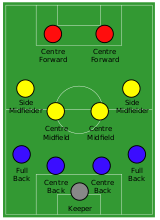



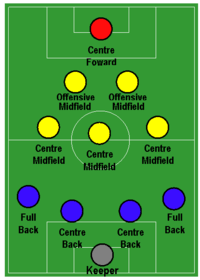

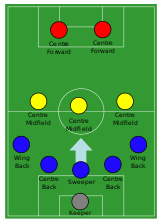
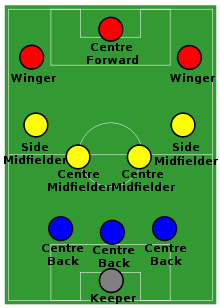






.svg.png)